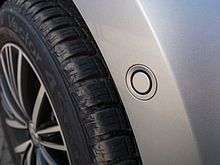Parking sensor
Parking sensors are proximity sensors for road vehicles designed to alert the driver of obstacles while parking. These systems use either electromagnetic or ultrasonic sensors.
Ultrasonic systems

These systems feature ultrasonic proximity detectors to measure the distances to nearby objects via sensors located in the front and/or rear bumper fascias or visually minimized within adjacent grills or recesses.
The sensors emit acoustic pulses, with a control unit measuring the return interval of each reflected signal and calculating object distances.[1] The system in turns warns the driver with acoustic tones, the frequency indicating object distance, with faster tones indicating closer proximity and a continuous tone indicating a minimal pre-defined distance. Systems may also include visual aids, such as LED or LCD readouts to indicate object distance. A vehicle may include a vehicle pictogram on the car's infotainment screen, with a representation of the nearby objects as coloured blocks.
Rear sensors may be activated when reverse gear is selected and deactivated as soon as any other gear is selected. Front sensors may be activated manually and deactivated automatically when the vehicle reaches a pre-determined speed — to avoid subsequent nuisance warnings.
As an ultrasonic systems relies on the reflection of sound waves, the system may not detect flat objects or object insufficiently large to reflect sound — e.g., a narrow pole or a longitudinal object pointed directly at the vehicle or near an object. Objects with flat surfaces angled from the vertical may deflect return sound waves away from the sensors, hindering detection. Also soft object with strong sound absorption may have weaker detection, e.g. wool or moss.
The Parking Sensor, originally called as ReverseAid, was a spin-off from the Sonic Pathfinder,[2] an Electronic Guidance Device for the Blind. Both devices were invented in the late 1970s by Tony Heyes while working at the Blind Mobility Research Unit at Nottingham University in the UK. After patenting the device in 1983 Heyes offered it to Jaguar Cars in Coventry. After test driving the prototype on Heyes's car they very politely told him that, "You like it because you are a one-eyed driver who cannot judge distances. Real people would not want a thing like this."
Heyes teamed up with a local manufacturer and some 150 units were made and fitted to petrol tankers, trucks and delivery vehicles. Very few were fitted to private cars since few people wanted to drill holes into their cars.
Electromagnetic systems
The electromagnetic parking sensor (EPS) was re-invented and patented in 1992 by Mauro Del Signore.[3] Electromagnetic sensors rely on the vehicle moving slowly and smoothly towards the object to be avoided. Once detected, the obstacle, if the vehicle momentarily stops on its approach, the sensor continues to give signal of presence of the obstacle. If the vehicle then resumes its manoeuvre the alarm signal becomes more and more impressive as the obstacle approaches. Electromagnetic parking sensors are often sold as not requiring any holes to be drilled offering a unique design that discreetly mounts on the inner side of the bumper preserving the 'new factory look' of your vehicle. Now they also come equipped with a camera to go with the sensor. By 2018 the US is requiring back up camera with sensors on all cars.
Blind spot monitors and other technology
Blind spot monitors are an option that may include more than monitoring the sides of the vehicle. It can include "Cross Traffic Alert," "which alerts drivers backing out of a parking space when traffic is approaching from the sides."[4][5][6]
Inventors
The Parking Sensor was first invented by Dr Tony Heyes in the late 1970s, a spin-off from an aid for the blind. Heyes patented it in 1983. It had a modest beginning: see above under Ultrasonic Systems.
Toyota introduced ultrasonic Back Sonar on the 1982 Toyota Corona, offering it until 1988.[7] December 13, 1984 Massimo Ciccarello and Ruggero Lenci (see List of Italian inventors) entered in Italy the patent request for ultrasonics Parking sensors, and November 16, 1988 the Ministry of Industry granted them the Patent for industrial invention n. 1196650.[8]
See also
- Automatic parking
- Backup collision
- Backup camera
- Blind spot monitor
- Blind spot (vehicle)
- Intelligent Parking Assist System
- Experimental Safety Vehicle (ESV)
- Intelligent car
- Lane departure warning system
- Objects in mirror are closer than they appear
- Omniview technology
- Precrash system
- Rear-view mirror
- Side-view mirror
- Wing mirror
References
- "Mercedes Benz Parktronic system (PTS)". Launch Tech. Archived from the original on 2009-05-01. Retrieved 2008-07-13.
- "Gateway to Perceptual Alternatives". Perceptual Alternatives.
- "Electromagnetic Parking Sensor patent".
- Ford Motor Company (2008). "See It, Hear It, Feel It: Ford Seeks Most Effective Driver Warnings for Active Safety Technology. Increased warnings indicate potentially hazardous lane changes". Gale, Cengage Learning/Free Library. Retrieved August 11, 2013.
- Jensen, Christopher (August 18, 2009). "Are Blind Spots a Myth?". The New York Times. Retrieved August 9, 2013.
- Automobile Blind-Spot Monitoring System, Tri-City Insurance News, January 27, 2006 Archived December 13, 2009, at the Wayback Machine
- https://newsroom.toyota.co.jp/en/detail/7675511
- "Fonte: UIBM Ministero dello Sviluppo Economico". Archived from the original on 2015-02-08. Retrieved 2015-02-09.
External links
| Wikimedia Commons has media related to Parking sensors. |
- Proxel - Operating principle of Electromagnetic Parking Sensor
- Parking Sensors patented in Italy
- "The danger of blind zones The area behind your vehicle can be a killing zone". Consumer Reports. Consumers Union. March 2012. Retrieved August 10, 2013.